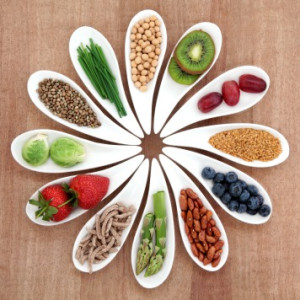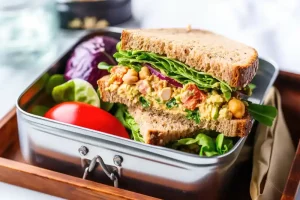
Eating foods rich in fiber can be a great way to keep our bodies feeling satisfied, strong, and healthy.
So what exactly is fiber? Dietary fiber is a type of carbohydrate that adds bulk to the diet. It also aids with digestion and helps maintain regular bowel movements. Did you know that eating a high-fiber diet can help prevent weight gain? Fiber-rich eating plans are typically lower in calories and full of foods that make you feel full faster.
Fiber comes in two forms, soluble (dissolves in water) and insoluble (does not dissolve in water). Most plants contain both soluble and insoluble fiber, but the amount of each type varies in different plant foods. While both types are important, they have very different effects on your health.
Insoluble Fiber
When most people think about fiber, their minds automatically go to the “roughage” found in most fruits, vegetables, and whole grains. This type of fiber is insoluble. Insoluble fiber “sweeps through the colon like a broom,” cleaning away the residue left by other foods (3). This type of fiber:
- Prevents constipation and diarrhea
- Decreases risk for:
- Colon cancer
- Varicose veins, hemorrhoids, and diverticulitis
- Obesity
Soluble Fiber
Soluble fiber is just as important as insoluble fiber and can be found in foods like oats, apples, peas, and beans. Soluble fiber absorbs water and creates bulk in the stools. It also helps:
- Reduce cholesterol
- Decrease risk for:
- Heart disease
- Osteoporosis
- Cancers like breast and bone
- Diabetes
The average person should make it a goal to eat at least 25 grams of fiber per day. Many children do not get enough fiber. Fiber can be found in plant foods like whole grains, nuts, beans, and fruits and vegetables. When increasing fiber intake, it is equally important to drink plenty of water to stay hydrated and push foods through the body. So how should you incorporate more fiber into your diet? Here are 6 ways to get started.
Eat more fruits and vegetables
These foods are packed with insoluble fiber, and they contain other important nutrients that are vital to health, too. By including 4-5 servings of vegetables and 2-3 servings of fruit in your meals and snacks each day, you can be on your way to meeting your needs . Try to keep the skins of fruits and vegetables on to reap the most benefit.
Look for whole grains
Refined grains like white bread contain little to no fiber. An easy way to make sure you are getting enough fiber is to buy whole wheat or whole-grain bread, cereals, rice, tortillas, or pastas. Whole grains may taste a little different than their refined counterparts, but once you start including these slightly nutty-tasting grains in your diet, you may never go back! Aim to make at least half (ideally 75%) of the grains you eat whole grains. Have fun with these healthy whole grain activities for kids.
Pay attention to food labels
It can be difficult to know if the foods you eat are high in fiber, which is why reading the food label is helpful. Before you purchase a “granola” or “wheat” product, check the food label and make sure that that the product contains fiber. Aim for 3-5g or more of fiber per serving. You can also read the ingredient list to make sure the first word listed is “whole,” as in whole grain or whole wheat. Products sometimes claim to be “wheat” or “enriched”, but are still missing the part of the grain that is beneficial to the body. You can also look for products labeled “100% whole wheat.”
Follow the MyPlate example
According to the USDA MyPlate guidelines on healthy eating and portion sizes, half of our plate should be filled with fruits and vegetables, a quarter should be whole grains, and the other quarter protein. This means that ideally, three quarters of your plate should contain fiber-rich foods!
Rethink fast food
Fast food lacks fiber, and a lot of the greasy, fried options can cause digestive distress. If fast food is the only option, seek out choices like apple slices or carrot sticks with dip, oatmeal, and salads with dressing on the side. You can also try asking for a whole grain bun or tortilla. Try to always carry a quick fiber-rich snack with you like nuts, popcorn, or a piece of fruit. That way you can prevent over-doing it at the fast food stops
Add seeds to your diet
Chia seeds and ground flaxseeds are packed with fiber, and you can add them to foods that you already eat! Toss chia seeds into smoothies or combine them with milk or yogurt to make a chia pudding. Add a tablespoon of ground flaxseed to yogurt or oatmeal in the morning, or stir some into your favorite muffin or pancake batter. Who’s hungry?
If you follow these simple guidelines, you can be that much closer to a fiber rich diet and healthier lifestyle!
Test Your Knowledge
What kind of fiber is found in most fruits and vegetables? What are the benefits of this type?
- Insoluble fiber is found in fruits and vegetables; it prevents diarrhea and constipation as well as reduces risk of colon cancer, obesity, hemorrhoids, diverticulitis, and varicose veins.
When buying wheat products, what words should you look for in the ingredient list?
- Look for the words “whole wheat” or “whole grain” and make sure that the product has enough fiber to be considered a good source.
According to MyPlate, how much of the plate should be fruits and vegetables? How much should be grains? Protein?
- MyPlate recommends that half of your plate be filled with fruits and vegetables, a quarter filled with grains, and a quarter with protein.












